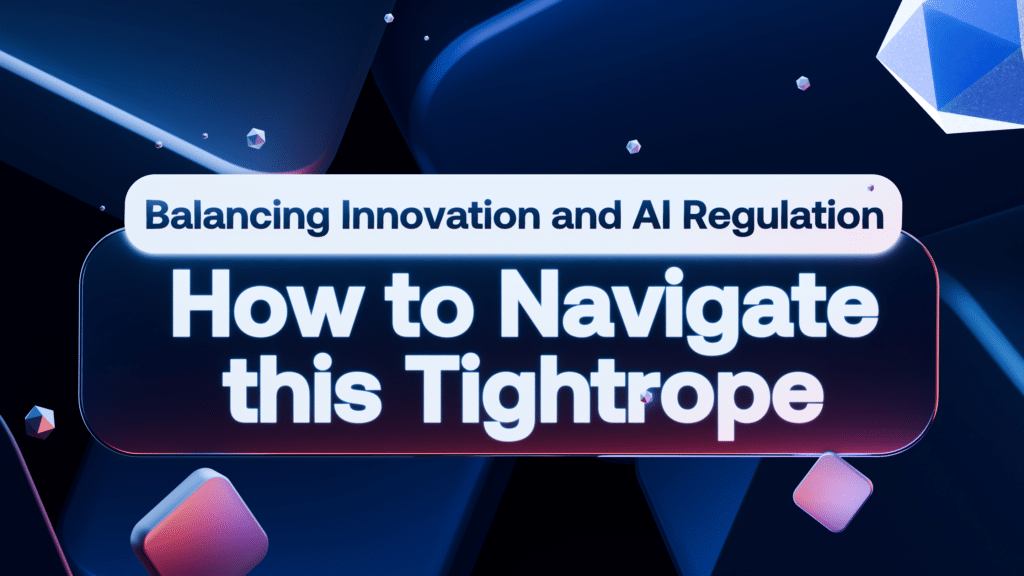
April 4, 2025 6 minutes read
Balancing Innovation and AI Regulation: How to Navigate this Tightrope

Sometime in 2016, Twitter (now X) users logged in to the app, as they’ve done before and what they met was truly shocking. Before that, there was a new chatbot, and this was 2016 so AI chatbots weren’t as popular as they are now so users were excited about this new AI tool. However, on this fateful day, the responses from the chatbot were rather inappropriate. It would generate racial slurs and disrepute sensitive events in history. This chatbot failed due to its unfiltered learning mechanism which is a result of failure in balancing innovation and AI regulation.
Quite understandably, many innovations in AI are limited due to the regulations surrounding the development of AI tools. The ethics of AI guide the use and development of AI tools by users and developers respectively. Without these guidelines, we would not have AI tools such as the Microsoft Tay chatbot of 2016 as described earlier. Or even worse.
In a world where we have self-learning algorithms controlling the activities of our day-to-day lives, these AI regulations protect users from malicious algorithms that would cause havoc. While these regulations are good, they limit innovations due to their rigid structure. However, by balancing innovation and AI regulation, developers can be as innovative as possible and create groundbreaking AI tools. The problem many developers face is navigating AI regulations for AI development.
In the article, we will discover ways to balance AI innovation and regulations.
Let’s get started!
What is AI regulation?
AI regulation refers to the policies and frameworks government and regulatory bodies put in place for guidance of the development, deployment, and use of artificial intelligence. These policies aim to ensure the ethical, safe, and beneficial use of artificial intelligence while addressing potential risks that may arise.
For now, developed governments of the world each have their own AI regulations. However, the common goal these regulations have is to ensure the safe use and deployment of AI.
The malicious Microsoft chatbot in 2016 was eventually taken down because it violated the United States AI regulations. Without AI regulations we would have AI tools like these still roaming the internet.
How do AI regulations affect innovation?
AI is a rapidly developing sector. Already, we have AI powering cars, apps, and sorting systems used in industries. Imagine a small startup developing an AI tool to help sort job applicants and pick out the best based on their qualifications, experience, and skills. The goal is to help companies reduce the time used in their employment process and eliminate human bias. In this scenario, there are no AI regulations. Soon, the tool might, unknowingly, start favoring a certain group of individuals over others regardless of their qualifications, experience, and skills. This bias defeats the whole aim of the hiring tool.
However, in a world where AI regulations exist like ours, we won’t have such problems. The only problem is when these rules are strict they limit the innovative process.
In such situations, companies spend time ensuring that they meet the compliance requirements. By doing so, startups fail to thrive since they might not have all the resources necessary to meet those requirements. This gives bigger competitors an advantage which will ultimately lead to the centralization of AI, but does not encourage innovation.
This highlights the importance of balancing innovation and AI regulation. This balance gives startups a chance also to deploy their AI technology, therefore fostering AI innovation. How then can balancing innovation and AI regulation be achieved?
Ways to balance innovation and AI regulation
Balancing innovation and AI technology is not a job for only one person or group. It takes the collaborative efforts of everyone including stakeholders, policymakers, AI developers, and users. It involves certain strategies to ensure that everything is stable. Here are some strategies for balancing innovation and AI regulation.
Joint policymaking
Policies are necessary to create a safe and friendly environment for the deployment and use of AI. However, formulating these policies has to be in collaboration with policymakers in the government and AI developers themselves including startups. This collaboration in making policies can lead to policies that are both practical and forward-thinking. Therefore, the policies made are fair to all developers and encourage innovation and at the same time safeguarding AI use and deployment.
Flexible and risk-based regulations
AI regulations should not be rigid and formulated on the level of risk applicable to each industry. A rigid set of regulations that is made to fit everything will be unfavorable when applied to some certain industries. For example, regulations for finance and health industries should be strict. However, when these same strict regulations are applied to a relatively lower-risk industry such as retail management, it restricts innovation. Therefore, regulations for lower-risk industries should be more lenient. This approach will encourage innovation in industries that handle low-risk operations while ensuring safety in high-risk industries.
International cooperation
Artificial Intelligence is global. As such, international collaboration is essential in developing regulations that are consistent worldwide and cover the basic rules across borders. For now, programs like the Global Partnership on AI (GPAI) are responsible for bringing countries together to share knowledge on AI regulations and unify these regulations. This encourages cross-border innovation and unifies AI governance.
Regular review of existing regulations
Although it has come very far, AI is still a growing industry. Forecasts from 2022 estimate that with the rapid growth of AI, its market revenue is expected to grow from $168.5 billion to $2,760.3 billion by 2032. This shows that there is still work to be done in the industry within the confines of AI regulations. It is possible that the AI regulations we have today might not support innovation soon. Therefore, a regular review of these regulations by the appropriate parties will ensure continuous innovation in AI.
Challenges in balancing innovation and AI regulation
Balancing innovation and AI regulation does not come without its fair share of challenges. Here are the challenges that may present:
- Rapid technological advancements: AI is evolving at a pace that is hard to keep up with. As such, it outgrows the development of regulatory frameworks.
- Geographical variability: Global variability complicates international collaboration as different countries have different ethics and, therefore, require varying regulatory approaches to AI.
- Data and privacy concerns: It is crucial to ensure that user data is safeguarded. However, the strict regulations to enforce data protection may sometimes limit the availability of data, which is necessary for the innovative process of AI development.
Conclusion
Balancing innovation and AI regulation is a dynamic and continuous process. It can only stop when all the AI tools have been developed and AI does not grow. Therefore, AI developers need to stay informed about updates and new regulations. AI regulation is the center around which innovation occurs. Therefore, adopting a balanced approach is the only way innovation will progress and AI will continue to thrive.
For updates and more, visit our WEBSITE today!

